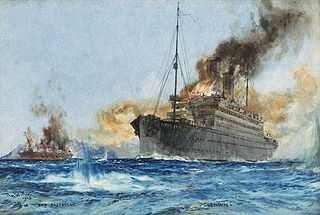
Merchant raiders are armed commerce raiding ships that disguise themselves as non-combatant merchant vessels.

An armed merchantman is a merchant ship equipped with guns, usually for defensive purposes, either by design or after the fact. In the days of sail, piracy and privateers, many merchantmen would be routinely armed, especially those engaging in long distance and high value trade.
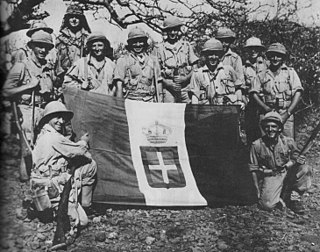
The East African campaign was fought in East Africa during the Second World War by Allies of World War II, mainly from the British Empire, against Italy and its colony of Italian East Africa, between June 1940 and November 1941. The British Middle East Command with troops from the United Kingdom, South Africa, British India, Uganda Protectorate, Kenya, Somaliland, West Africa, Northern and Southern Rhodesia, Sudan and Nyasaland participated in the campaign. These were joined by the Allied Force Publique of Belgian Congo, Imperial Ethiopian Arbegnoch and a small unit of Free French.

The Regia Marina was the navy of the Kingdom of Italy from 1861 to 1946. In 1946, with the birth of the Italian Republic, the Regia Marina changed its name to Marina Militare.
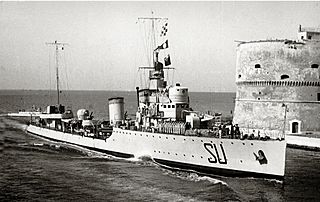
The Sauro class were a group of four destroyers built for the Regia Marina in the late 1920s. They were based in the Red Sea Italian colony of Eritrea and all fought in World War II being sunk during the East African Campaign in 1941.
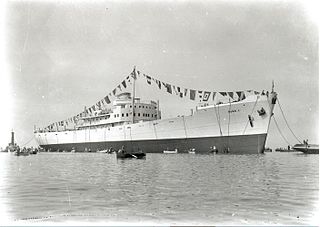
The Italian ship Ramb I was a pre-war "banana boat" converted to an auxiliary cruiser during World War II. Ramb I operated as an armed merchant in the Red Sea and was ordered to sail to Japan after the fall of Massawa to the Allies. She was sunk in the Indian Ocean before she could reach her intended destination.
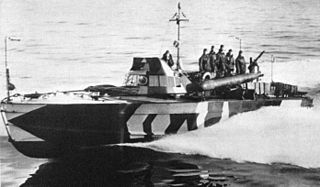
Motoscafo armato silurante, commonly abbreviated as MAS was a class of fast torpedo-armed vessels used by the Regia Marina during World War I and World War II. Originally, "MAS" referred to motobarca armata SVAN (armed motorboat SVAN, Società Veneziana Automobili Navali.

The Leone class were a group of destroyers built for the Italian Navy in the early 1920s. Five ships were planned and three completed. All three ships were based at Massawa, Eritrea during World War II and were sunk during the East African Campaign.
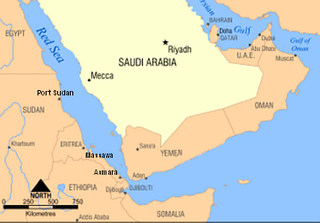
The Red Sea Flotilla was part of the Regia Marina Italia based at Massawa in the colony of Italian Eritrea, part of Italian East Africa. In World War II, the Red Sea Flotilla was active against the East Indies Station of the Royal Navy, from the Italian declaration of war on 10 June 1940 until the fall of Massawa on 8 April 1941.

The Italian auxiliary cruiser Ramb III was built at Genoa by Ansaldo in 1938.

The Italian auxiliary cruiser Ramb II was a pre-war banana boat built at Monfalcone by the CRDA in 1937. She briefly served as an auxiliary cruiser with Regia Marina early in World War II before becoming an auxiliary transport with the Imperial Japanese Navy later in her career.

Eritrea was a colonial ship of the Italian Regia Marina constructed in the Castellammare Shipyards near Napoli. Construction started in 1935 and she was commissioned in 1937. She served mainly in the Indian and western Pacific Oceans.

The Battle of the Strait of Otranto was a minor naval skirmish on 12 November 1940 during the Battle of the Mediterranean in World War II. It took place in the Strait of Otranto in the Adriatic Sea, between Great Britain and Italy.
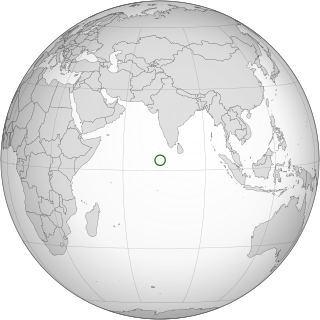
The action of 27 February 1941 was a single ship action between the British cruiser HMS Leander and the Italian auxiliary cruiser Ramb I. It began when Leander ordered an un-flagged freighter to stop for an inspection. The freighter raised the Italian colours and engaged Leander which sank Ramb I shortly after. Most of the Italian crew were rescued and taken to Addu Atoll, then Ceylon. Leander patrolled southwards to investigate more reports of commerce raiders.

Giovanni Bausan was a protected cruiser of the Italian Regia Marina that was designed and built by Sir W G Armstrong Mitchell & Co.'s Elswick Works in England in the mid-1880s. The finished ship entered service in May 1885. She was the first ship of this type to be built for the Italian fleet, and she provided the basis for subsequent designs built in Italy, including the Etna class. Giovanni Bausan was intended to serve as a "battleship destroyer", and was armed with a main battery of two 10-inch (254 mm) guns to give her the ability to defeat heavy armor, but design flaws rendered her unfit for this role.

Calabria was a small protected cruiser built for the Italian Regia Marina in the 1890s, intended for service in Italy's overseas empire. She was laid down in 1892, launched in 1894, and completed in 1897, and was armed with a main battery of four 15-centimeter (5.9 in) and four 12 cm (4.7 in) guns. Calabria spent significant periods abroad, ranging from deployments to Chinese, North American, and Australian waters, in addition to periods in Italy's East African empire. She saw action during the Italo-Turkish War in 1912 in the Red Sea, primarily bombarding Turkish ports in the area. Calabria was reclassified as a gunboat in 1921, reduced to a training ship in 1924, and sold for scrap at the end of the year.

Piemonte was a unique protected cruiser built for the Italian Regia Marina in the 1880s by the British shipyard Armstrong Whitworth. She was the first major warship armed entirely with quick-firing (QF) guns and she was also the fastest cruiser in the world upon her completion in 1889. Piemonte was frequently deployed overseas, including a lengthy tour in East Asian waters from 1901 to 1904. She saw significant action during the Italo-Turkish War in 1911–12 in the Red Sea, where she frequently bombarded Ottoman ports. During the Battle of Kunfuda Bay in January 1912, she and two destroyers sank four Ottoman gunboats and forced ashore three more. Piemonte participated in World War I but she saw little action during the conflict. She remained in service until 1920, when she was scrapped.

Elba was a protected cruiser of the Italian Regia Marina. She was the fifth of six Regioni-class ships, all of which were named for regions of Italy, with the exception of Elba, which was named for the island. Elba was built by the Regio Cantieri di Castellammare di Stabia; her keel was laid in September 1890, she was launched in August 1893, and she was commissioned in February 1896. The ship was equipped with a main armament of four 15 cm (5.9 in) and six 12 cm (4.7 in) guns, and she could steam at a speed of nearly 18 knots.
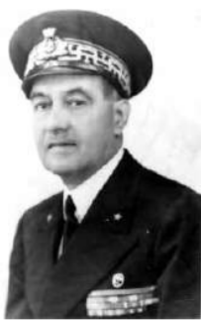
Mario Bonetti was an Italian admiral during World War II.



















